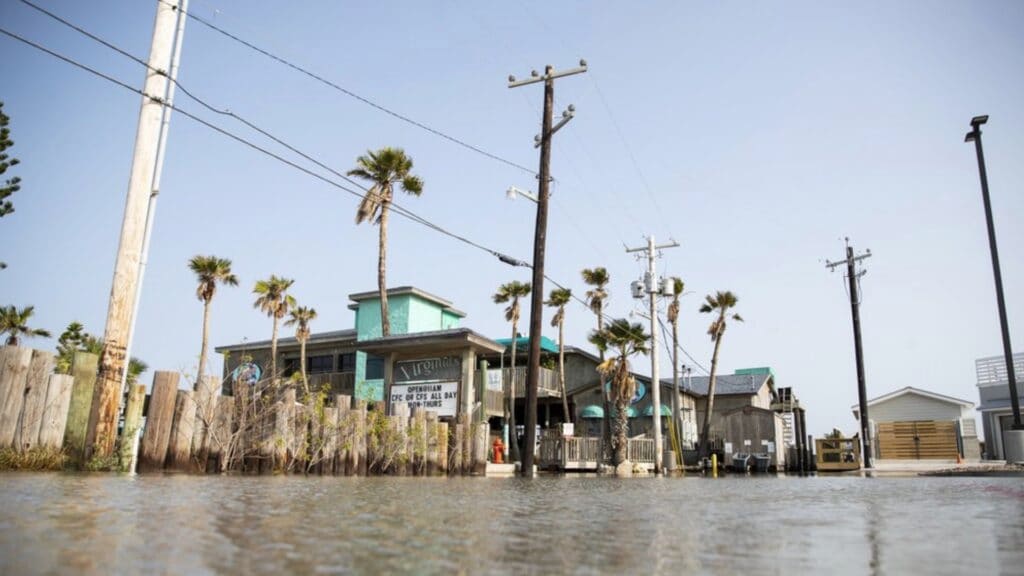Tropical Storm Beta trudged toward the coasts of Texas and Louisiana on Sunday, threatening to bring more rain, wind and stress to a part of the country that has already been drenched and battered during this year’s unusually busy hurricane season.
While Beta could bring up to 20 inches (51 centimeters) of rain to some areas of Texas and Louisiana over the next several days, it was no longer expected to reach hurricane intensity, the National Weather Service said Sunday.
Beta was set to make landfall along Texas’ central or upper Gulf Coast late Monday or early Tuesday, with rainfall as its biggest threat. It was then expected to move northeastward along the coast and head into Louisiana sometime mid-week.

Forecasters said Beta was not expected to bring the same amount of rainfall that Texas experienced during either Hurricane Harvey in 2017 or Tropical Storm Imelda last year. Harvey dumped more than 50 inches (127 centimeters) of rain on Houston and caused $125 billion in damage in Texas. Imelda, which hit Southeast Texas, was one of the wettest cyclones on record.
The first rain bands from Beta reached the Texas coast on Sunday, but the heaviest rain wasn’t expected to arrive until Monday into Tuesday.
In low-lying Galveston, which has seen more than its share of tropical weather over the years, officials didn’t expect to issue a mandatory evacuation order but they advised people to have supplies ready in case they have to stay home for several days if roads are flooded. The coastal city about 50 miles (80 kilometers) south of Houston could get up to 15 inches (38 centimeters) of rain.
Read More: Hurricane Laura destroys Confederate monument after officials vote to keep it
“We’re not incredibly worried,” Galveston resident Nancy Kitcheo said Sunday. Kitcheo, 49, and her family had evacuated last month when forecasts suggested Hurricane Laura could make landfall near Galveston, but they’re planning to buy supplies and wait out Beta. Laura ended up making landfall in neighboring Louisiana.
Kitcheo, whose home is 18 feet above the ground on stilts, said she expected her street to be impassable as water from rising tides was already flooding neighboring roadways on Sunday.
“This has definitely been more stressful, this hurricane season,” she said.
Galveston, which has about 50,000 residents, was the site of the deadliest hurricane in U.S. history, a 1900 storm that killed an estimated 6,000 people. The city was also hit hard in 2008 by Hurricane Ike, which caused about $30 billion in damage. Kitcheo’s previous home was heavily damaged during Ike and had to be torn down.
Beta was churning slowly through the Gulf of Mexico on Sunday morning about 140 miles (225 kilometers) southeast of Galveston, the U.S. National Hurricane Center said. The storm had maximum sustained winds of 60 mph (95 kph) and was moving west-northwest at 5 mph (8 kph).
In Victoria County, about 120 miles southwest of Houston, officials asked residents to prepare for up to 10 to 15 inches (25 to 38 centimeters) of rain.
“As with any event, panic is never helpful or necessary, but preparation is, and now is the time to finalize those plans,” said County Judge Ben Zeller, the top elected official in Victoria County.
Beta is forecast to dump heavy rain on the southwestern corner of Louisiana three weeks after the same area got pounded by Hurricane Laura. More than 41,000 homes and businesses remain without electricity, and Beta could add to that figure by toppling trees that were left leaning by the previous storm, said meteorologist Donald Jones of the National Weather Service office in Lake Charles, Louisiana. Storm debris from Laura clogging draining ditches in hard-hit areas such as Lake Charles could increase the threat of flooding.
Beta was one of three named storms whirling in the Atlantic basin during an exceptionally busy hurricane season. If the system makes landfall in Texas, it would be the ninth named storm to make landfall in the continental U.S. in 2020. That would tie a record set in 1916, according to Colorado State hurricane researcher Phil Klotzbach.
Forecasters ran out of traditional storm names on Friday, forcing the use of the Greek alphabet for only the second time since the 1950s.
Read More: Trump postpones New Hampshire rally over tropical storm
A stretch of the Gulf Coast from Port Aransas, Texas, about 165 miles (265 kilometers) southwest of Galveston, to Morgan City, Louisiana, 80 miles (128 kilometers) west of New Orleans, was under a tropical storm warning Sunday.
Meanwhile, Teddy remained a powerful hurricane on Sunday, with maximum sustained winds of 105 mph (165 kph) and moving northwest at 9 mph (14 kph). Teddy was centered 270 miles (435 kilometers) south-southeast of Bermuda less than a week after Hurricane Paulette made landfall in the wealthy British territory. A tropical storm warning was in effect for Bermuda.
Tropical Storm Wilfred was still at sea but was expected to dissipate by Tuesday.
Parts of the Alabama coast and Florida Panhandle were still reeling from the effects of Hurricane Sally, which roared ashore on Wednesday. At least two deaths were blamed on the system.
Associated Press reporters Kelli Kennedy in Fort Lauderdale, Florida, and Russ Bynum in Savannah, Georgia, contributed to this report.
Have you subscribed to theGrio’s podcast “Dear Culture”? Download our newest episodes now!












More Stories
Jasmine Crockett Called Out For ‘Cotton-Picking’ Comment – Black Enterprise
Lefty Texas Rep. Jasmine Crockett suggests US needs migrants because black people ‘are done picking cotton’ – New York Post
Trump Targets a Slavery Removal from the National Museum of African-American History and Culture – BlackPressUSA